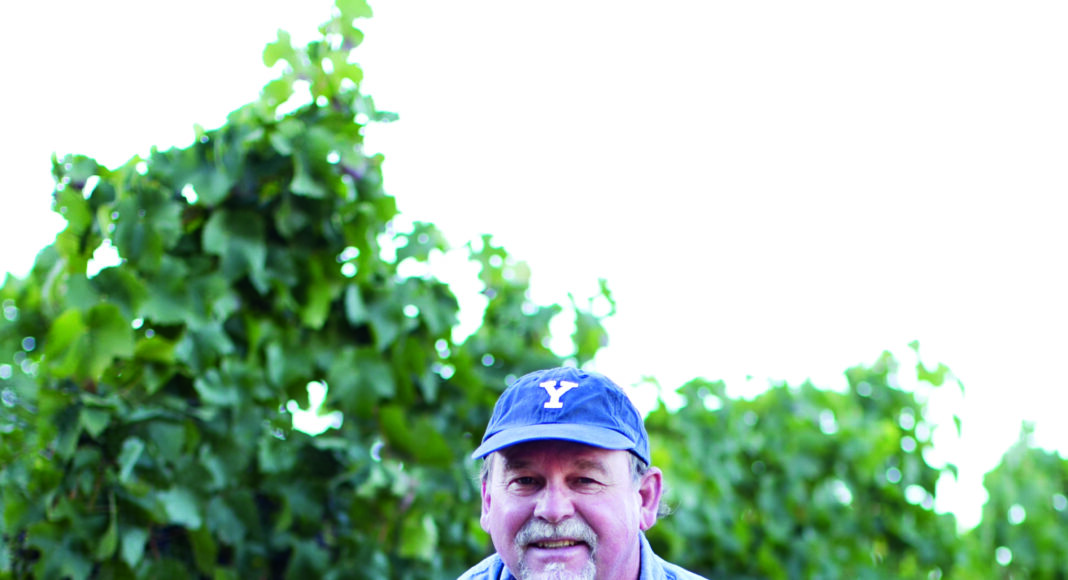Petaluma Gap wines are said to have a bit more balance and refinement because the wind hardens and thickens the grape skins, producing more tannins, which render the feeling of texture in your mouth. The microclimate produces wine with a combination of freshness, refinement and elegance with more intensity from the tannins.
But like the rest of the Bay Area, the Petaluma Gap climate is changing. At the Golden Gate Bridge, sea level rose 9 inches between 1854 and 2016 as a result of melting land ice and the thermal expansion of ocean water. Over the last 100 years, Bodega Bay sea level rose 8.5 inches. And since 1961, average ocean temperature at Point Reyes has risen about 2 degrees Fahrenheit.
Climate science is very complex. Stewart Johnson earned his bachelor’s degree from UC Berkeley, his master’s degree from Yale and his J.D. from Hastings. But none of it prepared him for the challenges of growing grapes on the Marin side of the Petaluma Gap, where the soil is particularly thick and tough for roots to penetrate. The drought put Chileno Valley Vineyards out of business and prevented Griffin’s Lair from delivering a crop last year.
“I irrigate with a pond that catches runoff every winter. Even through the previous years of drought, I always had a full pond. In 2021, I didn’t get a drop. I had to haul in recycled water,” says Johnson, who gave his Kendric Vineyards about half the water he usually does just to keep the pinot noir and syrah vines alive.
All in, it cost him $27,000 to bring in enough water to eke out what he considered to be a sacrificial crop. The syrah grapes hang longer and fared worse than his pinot noir. He used to get eight to 10 barrels of syrah. Last year, he only got one. Climate change exacted a hefty toll.
The Petaluma Gap, which comprises roughly 200,000 acres and 4,000 vineyard acres that get wind swept with fog from the Pacific Ocean, was first recognized in 2017 as an American Viticulture Area (AVA) for its unique Sonoma County microclimate. The AVA is defined by its wind pattern, and is home to roughly 90 vineyards, nine wineries and seven wine tasting rooms.
Warmer temperatures inland draw coastal fog from the Pacific Ocean through a gap in the mountains at Bodega Bay. The wind current travels east until it hits the Sonoma Mountains, where it gets deflected south to San Pablo Bay. So the Petaluma Gap is essentially a wind tunnel, and some of the AVA’s most famous vineyards—like Gap’s Crown, Robert’s Road and Sun Chase—are along the western side of the Sonoma Mountains, which serves as a sort of wind tunnel inflection point.
In April 2021, Gov. Gavin Newsom declared a drought emergency in Sonoma and Mendocino counties due to dry conditions in the Russian River watershed, which includes the hills and mountains that straddle the Russian River, as well as the mountains alongside the Eel River, which feeds into the Russian River at the Lake Mendocino Reservoir in Ukiah by means of a man-made diversion tunnel built in 1908.
In an attempt to defer water curtailments, local stakeholders launched a voluntary water sharing program for Upper Russian River rights holders earlier this month. Warmer temperatures make surface water evaporate faster. Add to that low precipitation, and you can start to see why wine growers have been hit so hard by climate change. For the last 26 consecutive months, Marin, Sonoma and Napa have been experiencing severe drought conditions.
“More than being hot, it’s unpredictable. And we’ve not had water for the past two or three years. We’ve been irrigating in March, which is something we have never done,” says Ana Keller, director at Keller Estates, which has vineyards, a winery and a tasting room in the Petaluma Gap.
“We lost grapes in 2010 and 2011 because they were the two coldest years on record in this part of Sonoma,” says Mitch Black, who grows grapes with his daughter, Lexine, at Black Knight Vineyards on Taylor Mountain, overlooking the Petaluma Gap. “We’re having such strong swings from cold to warm.” Black Knight grows Clone 828 Pinot Noir grapes originating from Dijon, France for Halleck Vineyard.
Combined land and ocean temperature has increased at an average rate of 0.13 degrees Fahrenheit per decade since 1880. But the average rate of increase since 1981 has jumped to twice that rate, according to the National Oceanic and Atmospheric Agency’s 2020 Annual Climate Report. Rising temperatures also means snowpack melts earlier, leading to dryer and more flammable vegetation, longer fire seasons and higher burn intensities.
Fires west of the Sonoma Mountains pose a much greater risk to Petaluma Gap wines. If the smoke from neighboring fires reaches a vineyard within 12 hours, it can ruin the crop. Unlike white wines, where the skins are discarded, pinot noir hangs on the vine longer and is extremely susceptible to smoke taint,” says Tom Gendall, director of winemaking and viticulture at Cline Cellars.
Three of the 10 most costly fires in the history of the U.S. were in 2020, according to a report from the Insurance Information Institute. And two out of those three were in wine country.
The LNU Lightning Complex fire, which started just south of the Quail Ridge Ecological Reserve on Aug. 17, 2020 and burned 363,220 acres, was responsible for $2.43 billion in damages and posed an agricultural threat to the Petaluma Gap, because it was west of the Sonoma Mountains, so the winds had the potential to envelop Gap vineyards with thick, black smoke.
“Wildfires are becoming a bigger source of loss for insurance companies in the last five years. And since 2017, Northern Californians are suffering more losses,” says Janet Ruiz, director of strategic communications at the Insurance Information Institute, a nonprofit, industry-backed association.
Eric Schwartzman is editor of the ‘Sonoma Wine Tasting Blog.’











